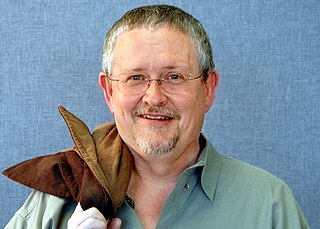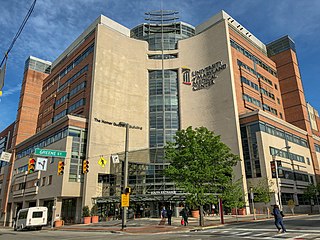
Biomedical engineering (BME) or medical engineering is the application of engineering principles and design concepts to medicine and biology for healthcare applications. BME is also traditionally logical sciences to advance health care treatment, including diagnosis, monitoring, and therapy. Also included under the scope of a biomedical engineer is the management of current medical equipment in hospitals while adhering to relevant industry standards. This involves procurement, routine testing, preventive maintenance, and making equipment recommendations, a role also known as a Biomedical Equipment Technician (BMET) or as a clinical engineer.

Gene therapy is a medical technology that aims to produce a therapeutic effect through the manipulation of gene expression or through altering the biological properties of living cells.

Speaker for the Dead is a 1986 science fiction novel by American writer Orson Scott Card, an indirect sequel to the 1985 novel Ender's Game. The book takes place around the year 5270, some 3,000 years after the events in Ender's Game. However because of relativistic space travel at near-light speed Ender himself is only about 35 years old.

Surgery is a medical specialty that uses manual and/or instrumental techniques to physically reach into a subject's body in order to investigate or treat pathological conditions such as a disease or injury, to alter bodily functions, to improve appearance, or to remove/replace unwanted tissues or foreign bodies. The subject receiving the surgery is typically a person, but can also be a non-human animal.

Ender's Shadow (1999) is a parallel science fiction novel by the American author Orson Scott Card, taking place at the same time as the novel Ender's Game and depicting some of the same events from the point of view of Bean, a supporting character in the original novel. It was originally to be titled Urchin, but it was retitled Ender's Shadow prior to release. Ender's Shadow was shortlisted for a Locus Award in 2000.

Xenocide (1991) is a science fiction novel by American writer Orson Scott Card, the third book in the Ender's Game series. It was nominated for both the Hugo and Locus Awards for Best Novel in 1992. The title is a combination of 'xeno-', meaning alien, and '-cide', referring to the act of killing, together meaning the act of killing populations of aliens; comparable to genocide.
The Legacy Virus is a fictional plague appearing in American comic books featuring the X-Men published by Marvel Comics. It first appeared in an eponymous storyline in Marvel Comics titles, from 1993 to 2001, during which it swept through the mutant population of the Marvel Universe, killing hundreds, as well as mutating so that it affected non-mutant humans as well.

Xenotransplantation, or heterologous transplant, is the transplantation of living cells, tissues or organs from one species to another. Such cells, tissues or organs are called xenografts or xenotransplants. It is contrasted with allotransplantation, syngeneic transplantation or isotransplantation and autotransplantation. Xenotransplantation is an artificial method of creating an animal-human chimera, that is, a human with a subset of animal cells. In contrast, an individual where each cell contains genetic material from a human and an animal is called a human–animal hybrid.

Red Prophet (1988) is an alternate history/fantasy novel by American writer Orson Scott Card. It is the second book in Card's The Tales of Alvin Maker series and is about Alvin Miller, the seventh son of a seventh son. Red Prophet won the Locus Award for Best Fantasy Novel in 1989, was nominated for the Nebula Award for Best Novel in 1988, and the Hugo Award for Best Novel in 1989.
Hypogammaglobulinemia is an immune system disorder in which not enough gamma globulins are produced in the blood. This results in a lower antibody count, which impairs the immune system, increasing risk of infection. Hypogammaglobulinemia may result from a variety of primary genetic immune system defects, such as common variable immunodeficiency, or it may be caused by secondary effects such as medication, blood cancer, or poor nutrition, or loss of gamma globulins in urine, as in nonselective glomerular proteinuria. Patients with hypogammaglobulinemia have reduced immune function; important considerations include avoiding use of live vaccines, and take precautionary measures when traveling to regions with endemic disease or poor sanitation such as receiving immunizations, taking antibiotics abroad, drinking only safe or boiled water, arranging appropriate medical cover in advance of travel, and ensuring continuation of any immunoglobulin infusions needed.
A transgene is a gene that has been transferred naturally, or by any of a number of genetic engineering techniques, from one organism to another. The introduction of a transgene, in a process known as transgenesis, has the potential to change the phenotype of an organism. Transgene describes a segment of DNA containing a gene sequence that has been isolated from one organism and is introduced into a different organism. This non-native segment of DNA may either retain the ability to produce RNA or protein in the transgenic organism or alter the normal function of the transgenic organism's genetic code. In general, the DNA is incorporated into the organism's germ line. For example, in higher vertebrates this can be accomplished by injecting the foreign DNA into the nucleus of a fertilized ovum. This technique is routinely used to introduce human disease genes or other genes of interest into strains of laboratory mice to study the function or pathology involved with that particular gene.

Shadows in Flight is a science fiction novella by American writer Orson Scott Card. When released in 2012, it became the twelfth book published in the Ender's Game series. The story follows on from where the original four "Shadow series" books left off. It is about Bean and his children discovering an ancient Formic "ark" during their journey in space. It was released in January of 2012. It was nominated for the Goodreads Choice Award for science fiction.

Viral vectors are tools commonly used by molecular biologists to deliver genetic material into cells. This process can be performed inside a living organism or in cell culture. Viruses have evolved specialized molecular mechanisms to efficiently transport their genomes inside the cells they infect. Delivery of genes or other genetic material by a vector is termed transduction and the infected cells are described as transduced. Molecular biologists first harnessed this machinery in the 1970s. Paul Berg used a modified SV40 virus containing DNA from the bacteriophage λ to infect monkey kidney cell maintained in culture.

Orson Scott Card is an American writer known best for his science fiction works. He is the only person to have won a Hugo Award and a Nebula Award in consecutive years, winning both awards for his novel Ender's Game (1985) and its sequel Speaker for the Dead (1986). A feature film adaptation of Ender's Game, which Card co-produced, was released in 2013. Card also wrote the Locus Fantasy Award-winning series The Tales of Alvin Maker (1987–2003).

Medicine in ancient Rome was highly influenced by ancient Greek medicine, but also developed new practices through knowledge of the Hippocratic Corpus combined with use of the treatment of diet, regimen, along with surgical procedures. This was most notably seen through the works of two of the prominent Greek physicians, Dioscorides and Galen, who practiced medicine and recorded their discoveries. This is contrary to two other physicians like Soranus of Ephesus and Asclepiades of Bithynia, who practiced medicine both in outside territories and in ancient Roman territory, subsequently. Dioscorides was a Roman army physician, Soranus was a representative for the Methodic school of medicine, Galen performed public demonstrations, and Asclepiades was a leading Roman physician. These four physicians all had knowledge of medicine, ailments, and treatments that were healing, long lasting and influential to human history.

The University of Maryland Medical Center (UMMC) is a teaching hospital with 806 beds based in Baltimore, Maryland, that provides the full range of health care to people throughout Maryland and the Mid-Atlantic region. It gets more than 26,000 inpatient admissions and 284,000 outpatient visits each year. UMMC has approximately 9,050 employees at the UMMC Downtown Campus, as well as 1,300 attending physicians and 950 resident physicians across the Downtown and the Midtown campuses. UMMC provides training for about half of Maryland's physicians and other health care professionals. All members of the medical staff are on the faculty of the University of Maryland School of Medicine.
Transplantable organs and tissues may refer to both organs and tissues that are relatively often transplanted, as well as organs and tissues which are relatively seldom transplanted. In addition to this it may also refer to possible-transplants which are still in the experimental stage.

HIV/AIDS research includes all medical research that attempts to prevent, treat, or cure HIV/AIDS, as well as fundamental research about the nature of HIV as an infectious agent and AIDS as the disease caused by HIV.
Biological warfare (BW)—also known as bacteriological warfare, or germ warfare—has had a presence in popular culture for over 100 years. Public interest in it became intense during the Cold War, especially the 1960s and '70s, and continues unabated. This article comprises a list of popular culture works referencing BW or bioterrorism, but not those pertaining to natural, or unintentional, epidemics.
The hazards of synthetic biology include biosafety hazards to workers and the public, biosecurity hazards stemming from deliberate engineering of organisms to cause harm, and hazards to the environment. The biosafety hazards are similar to those for existing fields of biotechnology, mainly exposure to pathogens and toxic chemicals; however, novel synthetic organisms may have novel risks. For biosecurity, there is concern that synthetic or redesigned organisms could theoretically be used for bioterrorism. Potential biosecurity risks include recreating known pathogens from scratch, engineering existing pathogens to be more dangerous, and engineering microbes to produce harmful biochemicals. Lastly, environmental hazards include adverse effects on biodiversity and ecosystem services, including potential changes to land use resulting from agricultural use of synthetic organisms.














